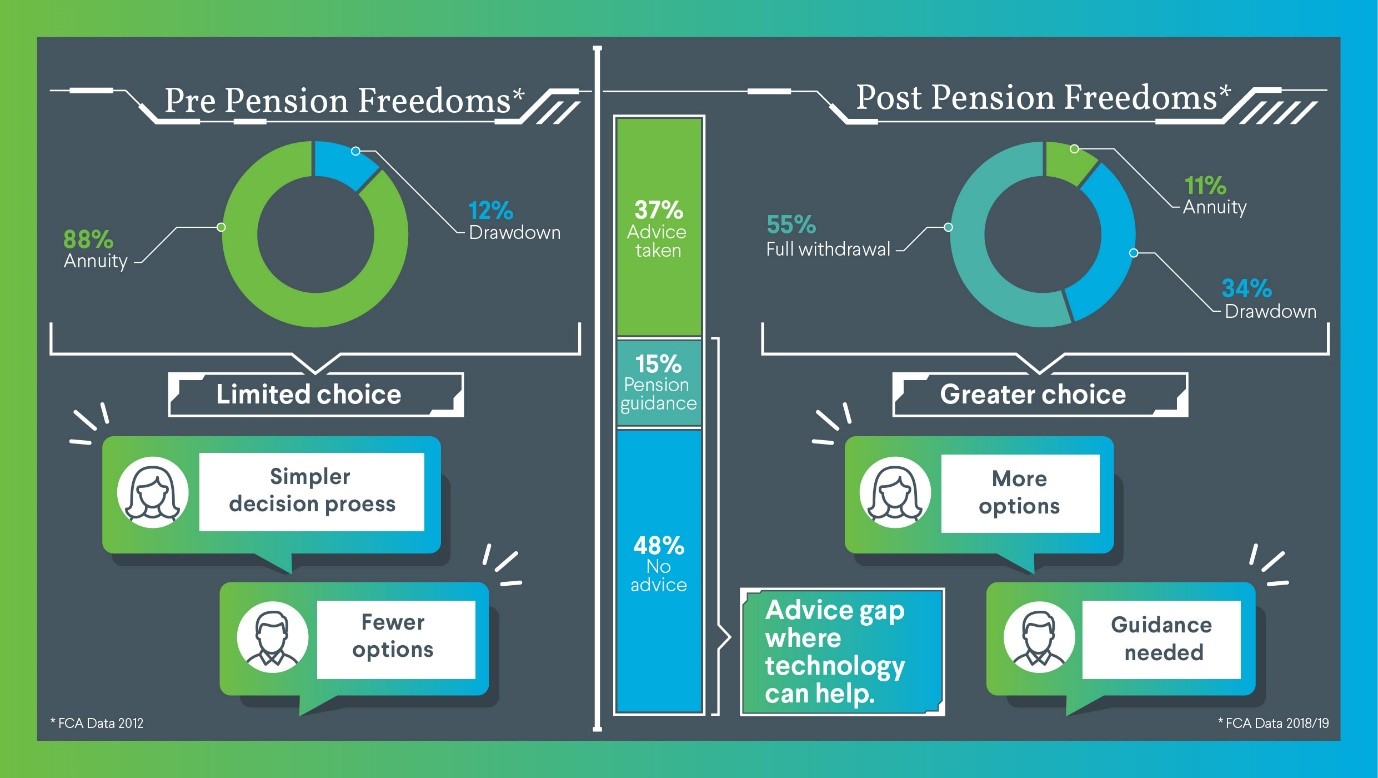Bridging the engagement gap
15 Jul 2020
Without a doubt, the introduction of pensions freedoms in 2015 has had a major impact on decision making for investors approaching, at, and beyond retirement age.
The increasing use of drawdown products and cash withdrawals, and reduction in annuities purchased, are amongst the most obvious impacts of the changes, illustrated below:
While the greater choice and freedom should be welcomed on the whole, it does mean that savers must make more complex decisions when planning how to use their accrued pension pot. Worryingly, according to FCA data, only 37% of savers sought financial advice regarding their retirement plans in 2018/19.
Unfortunately, there is little evidence that the increased freedoms have led to an uptick in engagement with long term pensions planning or sophistication in decision making from savers. This will only become a bigger issue in the coming years as reliance on DC savings becomes more of the norm for individuals approaching retirement.
Unsurprisingly, the FCA is concerned – in their business plan for 2020/21 they voice this concern:
- “We see significant risk of harm in these markets – driven by consumers given responsibility for complex investment decisions through shift to DC and Freedom and Choice”.
- “Consumers making unsuitable product choices in retirement could, collectively, lose £20 billion from unsuitable investment strategies over 5 years”.
Not only does the FCA see the risk, it also believes the industry is not providing the solutions it should be. It cites pensions and retail investments as products that can expose consumers to too much risk unknowingly, don’t always deliver value for money, and that are not consistently marketed clearly and fairly.
In addition, the access to guidance and advice is also highlighted as a current market failing:
- “Our view is the investment distribution process and support network around it is not working well enough”.
So is all of that fair?
Well as always, it is easy to criticise and blame the industry, when the challenges are deeper and more complex than that.
I believe the root of the problem is low ongoing engagement from consumers. It is a much-repeated truth that consumers don’t engage easily with retirement products, whether it be advised or non-advised, robo or face to face. The problem for providers is that they need at least some form of regular engagement from people to help ensure the product, savings rates and investment strategy continue to meet a customer’s needs. Unless they have an advisor and some form of annual review, customers will often default to a “set and forget” strategy, with their financial focus permanently drawn to more day to day and short-term needs. It’s hardly a surprise then, to find there are numerous examples where retirement income does not match an individual’s specific needs.
Market conditions are not helping either (even before the COVID 19 crash). Those people who have started saving more recently are seeing low and occasionally even negative real rates of return over short periods, compared to previous generations who generally saw more positive growth, according to the FCA's report. A tough starting place to encourage positive engagement from, which can at times feel like an unfixable problem!
Nevertheless, it remains our problem to deal with. And it’s in everyone’s interests that we tackle it head on.
Assets held within the UK workplace retirement and savings market are set to grow from around £830billion today to £2.5 trillion in 10 years-time. No-one doubts the size of the prize in capturing part of that market and serving it effectively.
While it is impossible to get perfect outcomes for millions of UK consumers with little engagement from them, it is possible to do significantly better than the FCA's worst case examples today.
There are two strands to help bridge the ‘engagement gap’:
-
Digital technology and data: Over the past five years, the technology and data insights to enable a richer, more personalised retirement experience for consumers, has become much more accessible to the workplace retirement and savings market. Its applications lie across advised and non-advised propositions, from accumulation right through to end of life and inheritance planning.
In adopting this sort of technology, advisers’ jobs become easier, D2C propositions become more powerful, and firms get the added benefit of much richer management information to improve (and evidence) their governance processes.
-
Consumer behaviour: As a highly regulated industry with many prescriptive rules around the information we must provide to someone, it’s not surprising it doesn’t always land well with the end customer.
Periodically taking a step back and assessing what matters most to people, reflecting emerging social trends that are relevant (e.g. ESG in investments) and looking at behavioural science techniques, can lead to simple ways to tweak products and propositions and improve engagement from people.
With the FCA closely scrutinising this area in the year ahead and some specific requirements like investment pathways on the delivery roadmap, now is the moment to look outwards and identify those win-win development areas. Spend time now working to improve propositions to deliver better customer outcomes while enhancing your governance and risk protection to your business at the same time.




0 comments on this post